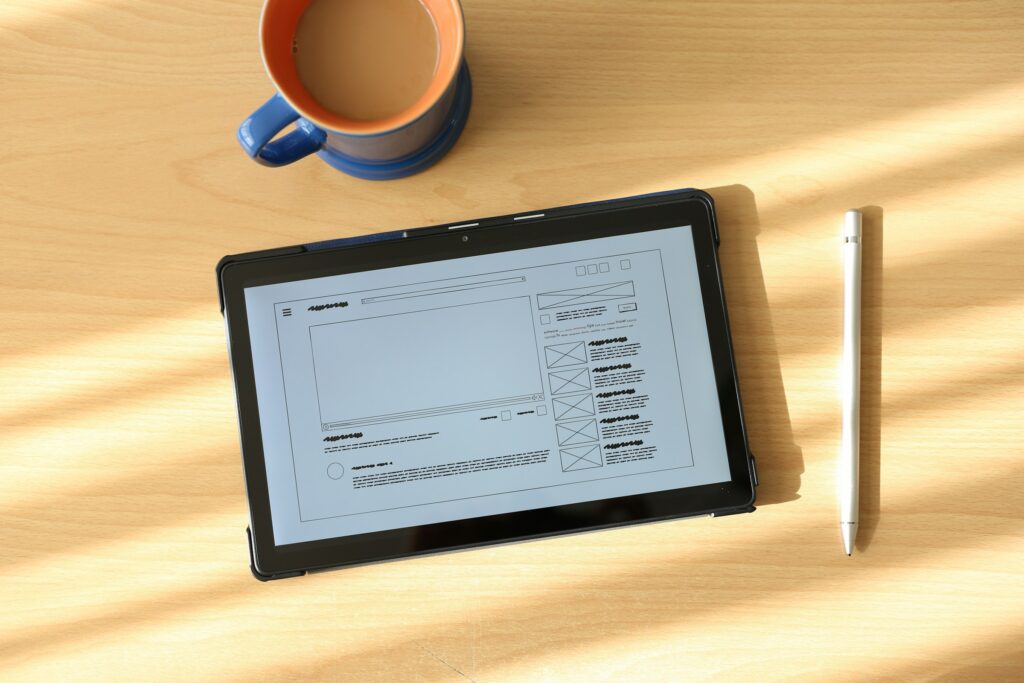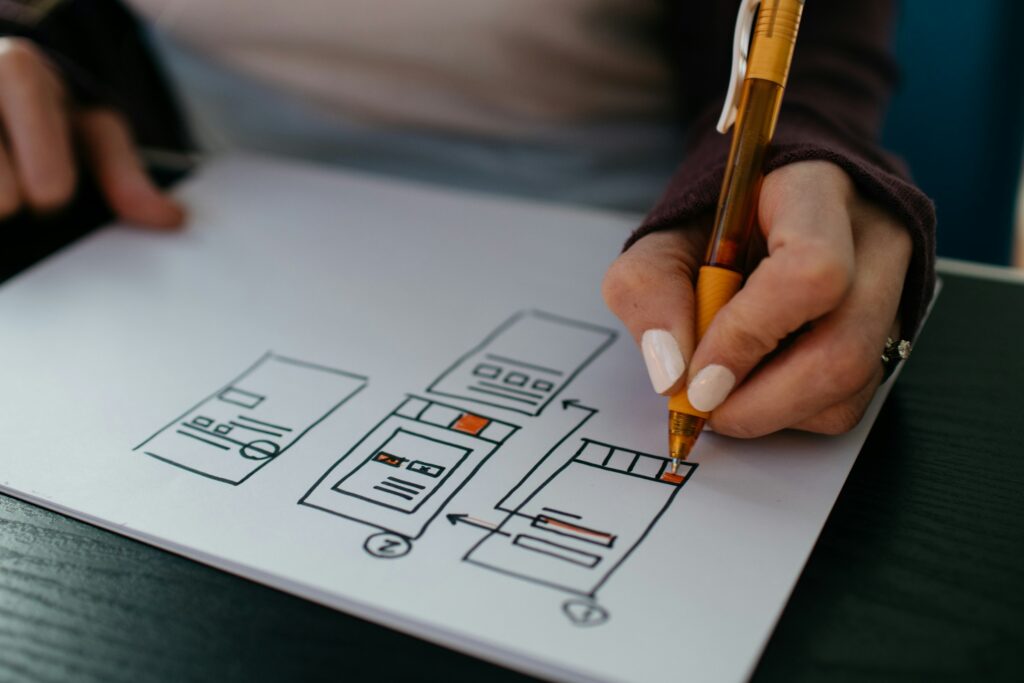In today's digital world, the UI/UX design plays a decisive role. Motion UI is revolutionizing the way we interact with websites and apps. These dynamic user interfaces combine appealing design with intuitive usability.
Interactive web designs use movement and Animationto present information in an understandable way. They direct the user's attention in a targeted manner and increase the User friendliness. The result is a unique Web experiencethat strengthens the brand identity.
Motion UI goes beyond static designs. It creates a seamless and engaging user experience through the clever use of visual elements. This technique helps to make complex content easier to understand and makes surfing the web a pleasure.
Important findings
- Motion UI improves interaction with digital products
- Dynamic elements make complex information easier to understand
- Interactive web designs increase the User friendliness
- Animations draw the user's attention in a targeted manner
- UI/UX design plays a key role for the Web experience
Introduction to Motion UI and interactive web design
Motion UI is revolutionizing the way we interact with digital interfaces. This innovative technology combines Animation and Responsive design into a seamless experience.
Definition and meaning of Motion UI
Motion UI describes the use of dynamic elements in user interfaces. It is about combining movement and Animation to improve the user experience. Clever animations can be used to present complex processes in an understandable way and make navigation more intuitive.
Advantages of dynamic user interfaces
Dynamic user interfaces offer numerous advantages:
- Increased user attention
- Improved information absorption
- More intuitive navigation
- Stronger emotional connection to the brand
Through the use of Microinteractions even small details can have a big impact. Subtle feedback on user actions increases satisfaction and makes interaction more pleasant.
Effects on the user experience
Motion UI has a profound impact on the user experience. Animations can Transitions between different states of an application and thus ensure a better understanding. Responsive design in combination with Motion UI enables movements and animations to be optimally displayed on all devices.
Motion UI is not just a visual trend, but a powerful tool for improving the User friendliness and commitment.
Through the targeted use of Motion UI, websites and applications can be made more lively, interactive and user-friendly. This leads to a positive perception of the brand and an improved overall experience for the user.
Basics of UI/UX design
UI/UX design forms the foundation for an optimal Web experience. It combines visual design with user-friendliness. In doing so Responsive design plays a central role in displaying websites optimally on all devices.
Important aspects of UI/UX design are:
- Information architecture
- Wireframing
- Prototyping
Designers need a deep understanding of user behavior and technical possibilities. Only then can they create products that are functional and appealing.
Close collaboration between UI and UX designers is crucial. It ensures that websites not only look good, but are also user-friendly.
Good design makes complex things simple.
An overview of the core elements in UI/UX design:
| UI element | UX aspect | Influence on user-friendliness |
|---|---|---|
| Color scheme | Readability | High contrast improves accessibility |
| Icons | Intuitive navigation | Quick recognition of functions |
| Responsive layout | Adaptability | Optimal web experience on all devices |
These fundamentals are essential for the Development of user-friendly Websites. They form the basis for advanced techniques such as Motion UI.
Motion UI: Interactive web designs
Interactive web designs are revolutionizing the way users interact with websites. They create dynamic and engaging experiences that keep visitors on the site longer and convey the message more effectively.
Core elements of interactive web design
The most important components include animated Transitionsthat gently fade in page content or elegantly open menus. Scrolling effects bring content to life as you scroll. Reactive elements adapt to user interaction and ensure an interactive experience.
Technologies behind Motion UI
CSS3 forms the basis for many animations and Transitions. JavaScript extends the possibilities and enables complex interactions. WebGL is used for sophisticated 3D graphics. These technologies work together to create fluid and appealing movements.
Best practices for implementation
When implementing Motion UI, there are a few points to bear in mind:
- Optimize performance: Animations should run smoothly and not affect the loading time.
- Consider accessibility: Movements must not exclude any users.
- Meaningful integration: Animations must contribute to the user experience, not distract from it.
- Finding a balance: Functionality and aesthetics should be in harmony.
The skillful application of these practices creates interactive web designs that inspire users and communicate effectively at the same time.
Microinteractions and their significance
Microinteractions play a central role in UI/UX design. These small but effective elements improve the User-friendliness of digital products considerably. They give the user visual feedback and make interaction with websites or apps more pleasant.

Well designed Microinteractions can strengthen the user's emotional connection to a product. Examples of this are animated buttons, loading animations or status changes. These subtle details contribute significantly to the overall quality of the user experience.
"Microinteractions are the salt in the soup of UI/UX design. They make the difference between a good and an outstanding user experience."
The implementation of microinteractions requires a sure instinct. They should support the user without distracting them. An overview of common microinteractions and their effect:
| Microinteraction | Function | Effect on user-friendliness |
|---|---|---|
| Hover effects | Visual feedback when the mouse is touched | Increases clarity and interactivity |
| Progress indicators | Visualization of processes | Reduces perceived waiting time |
| Pull-down menus | Compact presentation of options | Improves navigation and clarity |
Through the targeted use of microinteractions, designers can significantly improve user-friendliness and the overall UI/UX design. They are an indispensable tool for designing intuitive and appealing digital products.
Animation as a key element of the Motion UI
Animation plays a central role in Motion UI and gives user interfaces life and dynamism. Through the targeted use of animated elements, developers can significantly improve interaction with websites and apps.
Types of animations in user interfaces
Various types of animation can be found in modern interfaces:
- Transition effects between pages or menus
- Scrolling effects like parallax scrolling
- Hover animations for buttons or links
- Progress indicators and loading animations
Possible uses of animations
Animated elements can be used in a variety of ways:
| Field of application | Benefit |
|---|---|
| Directing attention | Highlighting important content |
| Functional declaration | Visualization of processes |
| Navigation | Intuitive user guidance |
| Feedback | Confirmation of user actions |
Performance optimization for animations
When implementing animations, performance optimization is crucial. CSS animations and WebGL techniques help to use resources efficiently. Developers should always find the balance between appealing effects and fast loading times to ensure an optimal user experience.
Responsive design and motion UI

Responsive design and Motion UI form a powerful combination for interactive web designs. The fusion of these technologies enables a dynamic web experience on different devices. However, the integration of moving elements into adaptable layouts poses challenges for developers.
Animations must work equally well on smartphones, tablets and desktops. An adaptive approach is the key here. Movements are adapted according to screen size and device performance. This ensures that the user experience remains consistent and appealing across all platforms.
For optimum results, designers should consider the following aspects:
- Simple animations for mobile devices
- More complex movements for desktop versions
- Reduction of animation time on smaller screens
- Use of CSS media queries to adjust movements
The following table shows examples of customizable Motion UI elements:
| Element | Mobile version | Desktop version |
|---|---|---|
| Menu | Easy gliding | 3D rotation |
| Picture gallery | Horizontal swipe | Zoom effect |
| Loading animation | Simple spinner | Complex particle animation |
The clever combination of responsive design and motion UI creates interactive web designs that are impressive on all devices. The result is a seamless and fascinating web experience for every user.
Accessibility in dynamic user interfaces
Accessibility plays an important role in the design of Motion UI. An inclusive web experience enables all users to access dynamic content. This presents designers with special challenges.
Challenges in the design of accessible Motion UI
The development of accessible UI/UX designs with motion elements involves hurdles. Users with visual impairments or limited motor skills can have problems grasping animated content. Screen readers also often reach their limits with dynamic elements.
Solutions and tools for inclusive designs
There are various approaches for more user-friendliness. Designers can include options for reducing or switching off animations. Alternative texts for visual elements improve accessibility. Special guidelines such as WCAG help with implementation barrier-free designs.
- Reduceable animations
- Alternative texts for visual content
- Support for screen readers
- Compliance with the WCAG guidelines
These measures can be used to create dynamic user interfaces that offer a positive web experience for all users. Accessibility should be integrated into the design process from the outset to create inclusive and accessible motion UI designs.
Trends and the future of Motion UI
The world of interactive web design is evolving rapidly. Motion UI is at the center of this evolution and is shaping the way we interact with digital interfaces. Current trends show an exciting future for UI/UX design.
3D elements are conquering the web landscape. They give websites depth and realism. Users delve deeper into digital worlds. AI-controlled animations adapt to user behavior. They create personalized experiences and increase interaction.
Virtual and Augmented reality merge with Motion UI. These technologies open doors to immersive experiences. Users interact more naturally with digital content. The boundaries between real and virtual are becoming blurred.
| Trend | Impact on UI/UX design | Benefits for users |
|---|---|---|
| 3D elements | More depth and realism | More intensive user experience |
| AI animations | Adaptive user interfaces | Personalized interaction |
| VR/AR integration | Immersive designs | More natural operation |
New web technologies are driving animation forward. They enable complex, fluid movements with high performance. The user experience becomes more intuitive and efficient. Motion UI continues to focus on user-friendliness and emotional appeal.
The future of Motion UI lies in the seamless fusion of technology and human interaction.
Interactive web designs are becoming increasingly intelligent and reactive. They adapt to the needs of users and create unique digital experiences. The future of UI/UX design promises an exciting journey into new dimensions of interaction.
Implementation of Motion UI in various industries
Motion UI is revolutionizing the web experience in numerous industries. The use of interactive web designs actively involves users and makes it easier to absorb information.
E-commerce and Motion UI
Motion UI ensures a dynamic product presentation in online retail. Customers can view items in 3D and test them virtually. The checkout process is made clearer by animated progress displays, which increases the conversion rate.
Motion UI in the education sector
Learning platforms benefit from UI/UX design with motion elements. Complex concepts are illustrated using interactive graphics and animations. Gamification elements motivate learners and promote knowledge building.
Use in the entertainment industry
Streaming services and gaming platforms use Motion UI for immersive experiences. Smooth transitions between menus and personalized recommendations with animated previews improve user engagement. In video games, interactive Web designs for seamless integration of game mechanics and user interface.
Industry-specific customization of Motion UI is critical to success. Companies need to understand the expectations of their target audience and optimize the UI/UX design accordingly to deliver an outstanding web experience.
Tools and resources for Motion UI development
The world of UI/UX design offers a wealth of tools for creating dynamic user interfaces. Adobe After Effects is a favorite for complex animations, while Figma has proven itself for UI design and prototyping. Developers often turn to frameworks such as React Spring to implement interactive web designs.
In addition to software, resources play an important role. Online courses impart specialist knowledge, design libraries provide inspiration and community forums offer support for tricky questions. This combination of tools and learning opportunities promotes continuous development in the field of Motion UI.
As technology advances, the tools for UI/UX design are becoming more sophisticated. This allows designers to create even more impressive animations and push the boundaries of interactive web design. Access to these resources opens doors for creative and efficient motion UI solutions.


Recent Comments